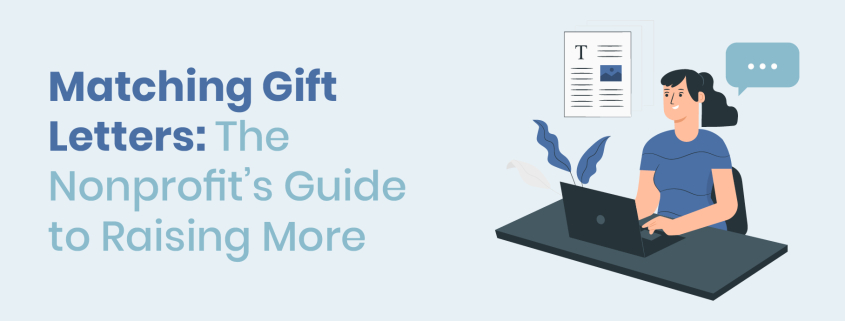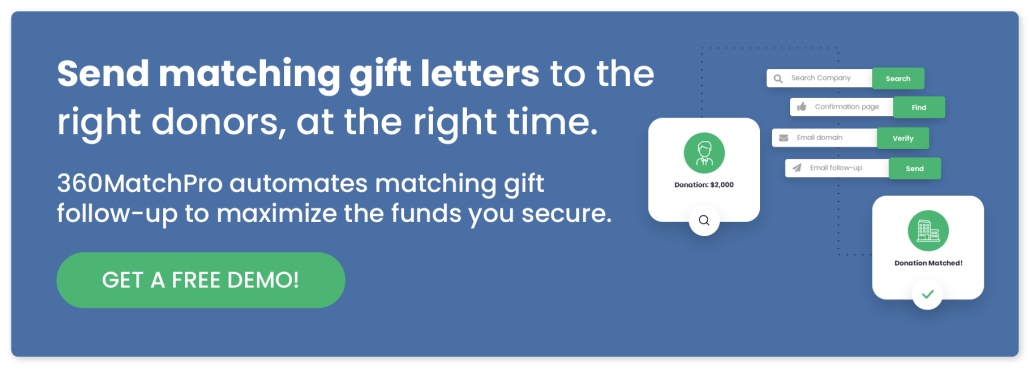Matching Gift Letters: The Nonprofit’s Guide to Raising More
When it comes to fundraising, you know that communication with your donors is key. By ensuring that they understand all of the opportunities for contributing to your mission, you can convert interest into impact. Corporate matching gifts are a powerful yet often overlooked way to secure significant funds for your nonprofit. While over 26 million individuals work for companies with matching gift programs, 78% of donors are unaware if their employer offers one of these programs.
This means that promoting these opportunities is essential. In this guide, we’ll walk through everything you need to promote matching gifts and tap into this game-changing source of revenue. Here’s what we’ll cover:
- How to Write Matching Gift Letters
- 16 Types of Matching Gift Letters to Send
- How to Raise More from Matching Gift Letters with Software
Weave matching gifts into your donor communications to spread awareness and build impactful relationships that last. Whether you’re new to these programs or looking to improve upon an existing strategy, explore these steps, templates, and examples to craft matching gift letters that maximize your fundraising success.
How to Write Matching Gift Letters
A matching gift letter, like any letter your nonprofit sends, should focus on catching the attention of your donor recipients and inspiring them to take action. Regardless of the format or communication channel you send it through, keep these tips in mind:
- Be direct and concise. Over the past few decades, human attention spans have shortened to an average of 47 seconds. Make it easy for readers to take in your main points at a glance by bolding or highlighting important details. Keep your letter short and to the point to avoid overwhelming them with long blocks of text.
- Focus on impact. Clearly demonstrate how matching gifts can make a difference to your mission. For example, you can share how much your nonprofit raised from matching gifts last year and what you were able to accomplish as a result. Were you able to send 200 more care packages to foster children in your city? Were you able to afford behavior training for 26 more shelter dogs to improve their chances of adoption?
- Include a call to action (CTA). Once you’ve made donors aware of matching gifts, encourage them to act upon that awareness by adding a specific CTA in your matching gift letter. Add eye-catching buttons with words like “Check your matching gift eligibility” in your digital content and include a QR code for print recipients interested in learning more.
Remember that tailored letters will perform better than generic mass messages. When possible, personalize your matching gift letters to each recipient by using their preferred name and mentioning other details about their past involvement with your nonprofit. They’ll be much more receptive and interested in what you have to say if they feel like you’re addressing them personally.
16 Types of Matching Gift Letters to Send
Matching gift letters come in varying shapes and sizes, each with its own purpose and ideal channel to send it through. By building a repertoire of matching gift communications for your nonprofit, you can streamline your outreach and leverage the right letters for the right occasions.
Take a look at these most common types of matching gift letters to start building your own:
1. Matching Gift Fundraising Appeal Letter
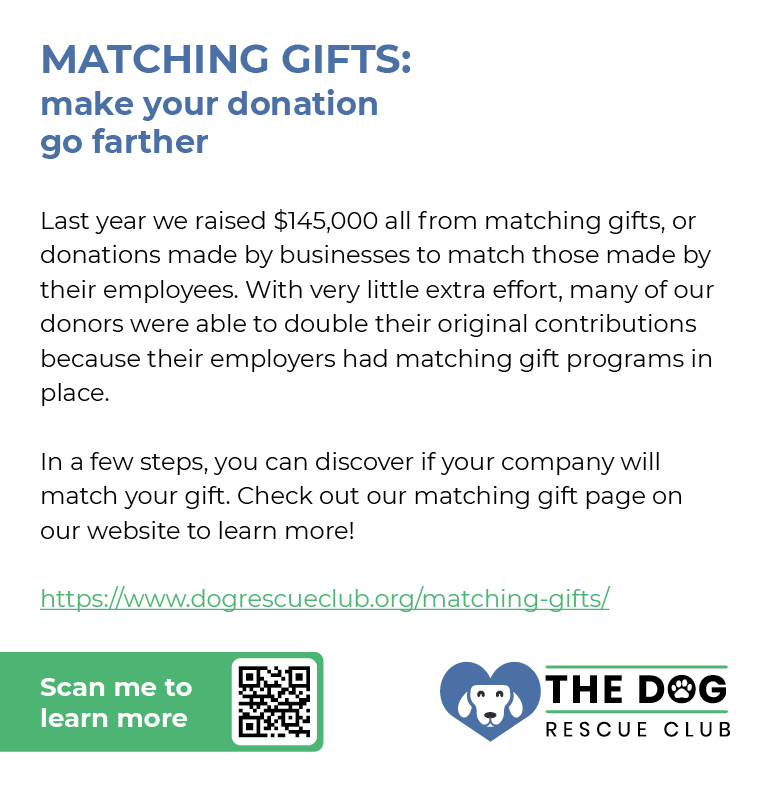
Matching gift programs are not merely a way for companies to demonstrate their commitment to corporate social responsibility (CSR) — they can also inspire more generosity among your donors and prospects.
In fact, 84% of donors report that they’re more likely to donate if a match is offered, and one in three would give a larger gift if they knew it would be doubled by their employer. By sending out matching gift fundraising appeal letters like the one above, your nonprofit can unlock substantial funds from first-time and existing donors alike.
In your matching gift fundraising appeals, be sure to:
- Use donor-centric language, such as “Make your donation go farther.”
- Mention specific data to highlight the impact of matching gifts and leverage social proof.
- Add links to both your donation page and matching gift resources.
This may be the first time that many of your audience members are hearing about matching gift opportunities. Therefore, keep your explanations simple and consider producing a variety of educational content that you can share with donors, such as a matching gift explainer video.
2. Donation Acknowledgement Matching Gift Letter
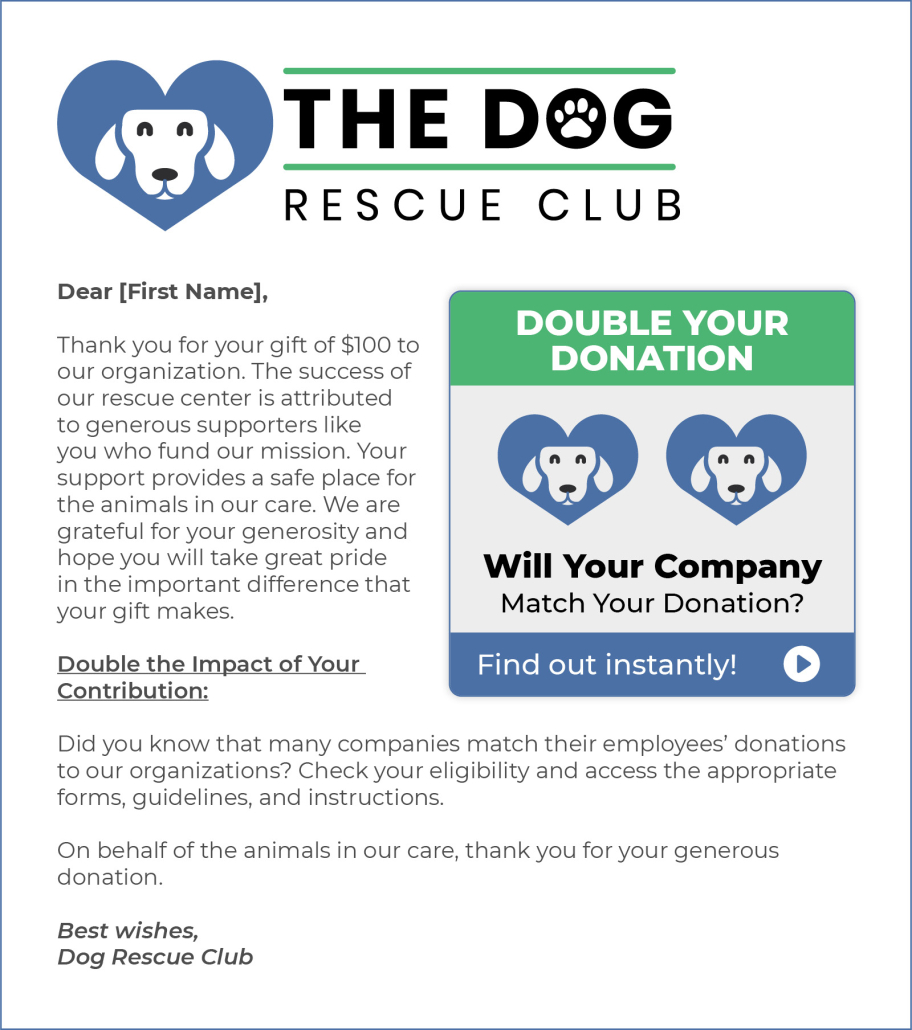
It’s no secret that gratitude is an essential part of any donor retention and stewardship strategy. After a donor gives to your nonprofit, they should receive an automated confirmation and thank-you email within 48 hours. This email presents the perfect opportunity to mention matching gifts as a way to make the donor’s contribution go twice as far.
To seamlessly incorporate matching gifts into your donor thank-you messages, consider these best practices:
- Focus on expressing your gratitude first.
- Include the specific gift amount and reference other involvement details.
- Add a link to additional matching gift resources so the donor can learn more.
Your donors give because they want to propel your mission forward. They’ll appreciate the opportunity to amplify their impact without having to contribute more from their own wallets.
3. Matching Gift Email
88% of people use their email every day, which is why the channel is such an important one for nonprofits trying to stay in touch with their donor base. However, it can be challenging to stand out in an inbox flooded with personal conversations, promotional offers, and other announcements.
Use these tips to craft click-worthy matching gift emails for your nonprofit:
- Write an engaging subject line that is less than 60 characters and includes the recipient’s name.
- Infuse elements of your branding, such as your colors and logo, into the email.
- Feature a prominent CTA button leading to your matching gift web page.
Once you’ve sent out your matching gift emails, track metrics such as your open rate and click-through rate to identify where you can improve your messaging in the future. For instance, you might determine that you need to adjust your subject line or make your CTA button more noticeable.
4. Matching Gift Newsletter Content

Neon One’s Nonprofit Email Report reveals that nonprofit email subject lines that contained the word “Newsletter” had an average open rate of 33.09% and higher click-through rates (7.42%) than those that didn’t (3.19%). This finding suggests that your nonprofit’s newsletter could be a useful tool for promoting matching gifts.
Whether you have a weekly or monthly newsletter in place, follow these best practices to add matching gifts to your content:
- Incorporate matching gifts into multiple sections of your newsletter.
- Provide a basic explanation of the steps involved in the matching gift process.
- Encourage people to participate by sharing the amount of matching gift funds donors have contributed in the past.
Both print and email newsletters can be effective for boosting awareness of matching gifts. Just remember to include links or QR codes to additional resources so donors know where to go for more details about these opportunities.
5. Printed Matching Gift Letter
While email is a quick and easy way to send out messages to your audience, a printed fundraising or thank-you letter can add a personal touch to your matching gift outreach. According to a USPS generational study, 71% of Baby Boomers and Gen X indicate that mail feels more personal than digital communications, 78% of Millennials read nonprofit mailers, and 72% of Gen Z say that they’re excited to discover what the mail brings every day.
Leave a lasting impression on your donors by sending them a printed matching gift letter. Be sure to:
- Make the letter visually appealing by featuring your brand colors, logo, and other imagery.
- Direct donors to your online matching gift resources via QR codes.
- Close the letter with the name of a recognizable individual at your nonprofit (such as your director) and their signature.
Due to expenses such as postage costs, it might not be feasible to send a printed matching gift letter to everyone in your donor database. Instead, focus on your top prospects to make the most of your outreach efforts.
6. Matching Gift Postcard
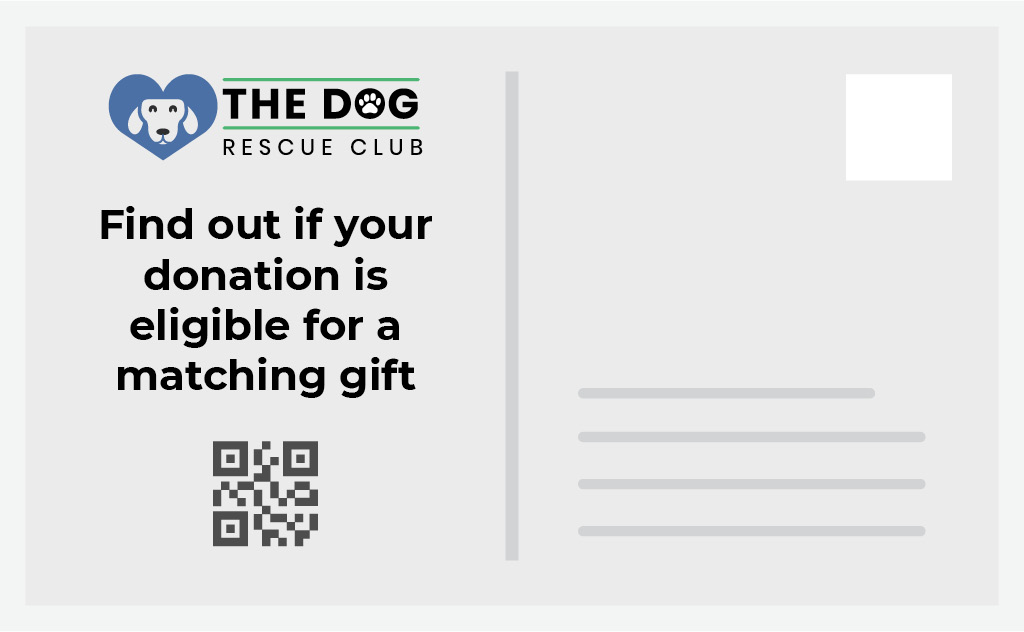
While receiving physical mail can stir up excitement among your audience members, the prospect of opening up bills, notices, or other less pleasant communications can lead to some reluctance and even mild stress. By sending a postcard, you can skip the anticipation and go straight to bringing a smile to your recipients.
Postcards are naturally brief and make nice keepsakes for your donors. Create stunning matching gift postcards with these tips:
- Convey the main purpose of your postcard with visual elements on the front and back.
- Limit your message to a couple of sentences at most.
- Add multiple ways for recipients to learn more, including a link, phone number, and QR code.
There are plenty of free nonprofit marketing tools that you can leverage to produce your postcards, from graphic design platforms to stock photo libraries. However, if you’d like to maximize your reach and send matching gift postcards to more donors in your community, consider designing eCards instead. This way, you can save on shipping costs and even add eye-catching animations to your content.
7. Year-End Matching Gift Letter
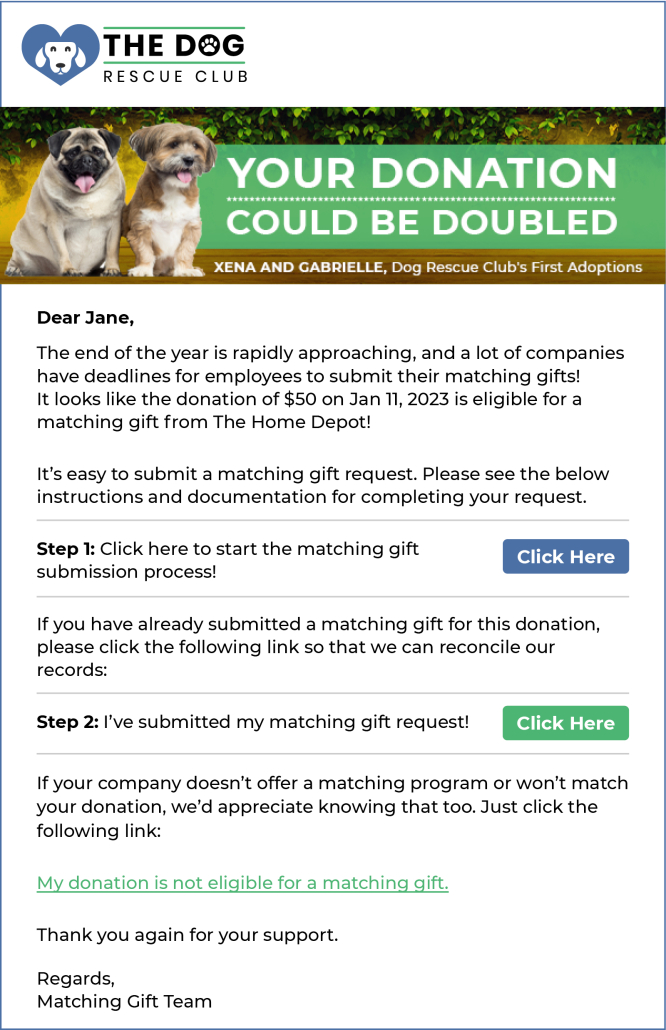
The end of the year is an ideal time to solicit matching gifts since the holidays tend to put people in a giving mood. To harness the generosity that abounds during these final months, schedule a year-end matching gift email stream that contacts donors about the contributions they’ve made to your nonprofit during the past year.
Make sure that your year-end matching gift letter or email follows these guidelines:
- Reference each gift amount and the date on which it was made.
- Include basic information about how donors can determine their matching gift eligibility.
- Instill a sense of urgency by mentioning common matching gift deadlines, such as the end of the calendar year.
To learn more tactics for securing matching gifts at year-end, check out our short explainer video:
As the video demonstrates, sending tailored, urgent matching gift messages to your donors at year-end can make it easy for them to determine their eligibility and maximize the chances that they submit a request.
8. Match-Eligible Donor Letter
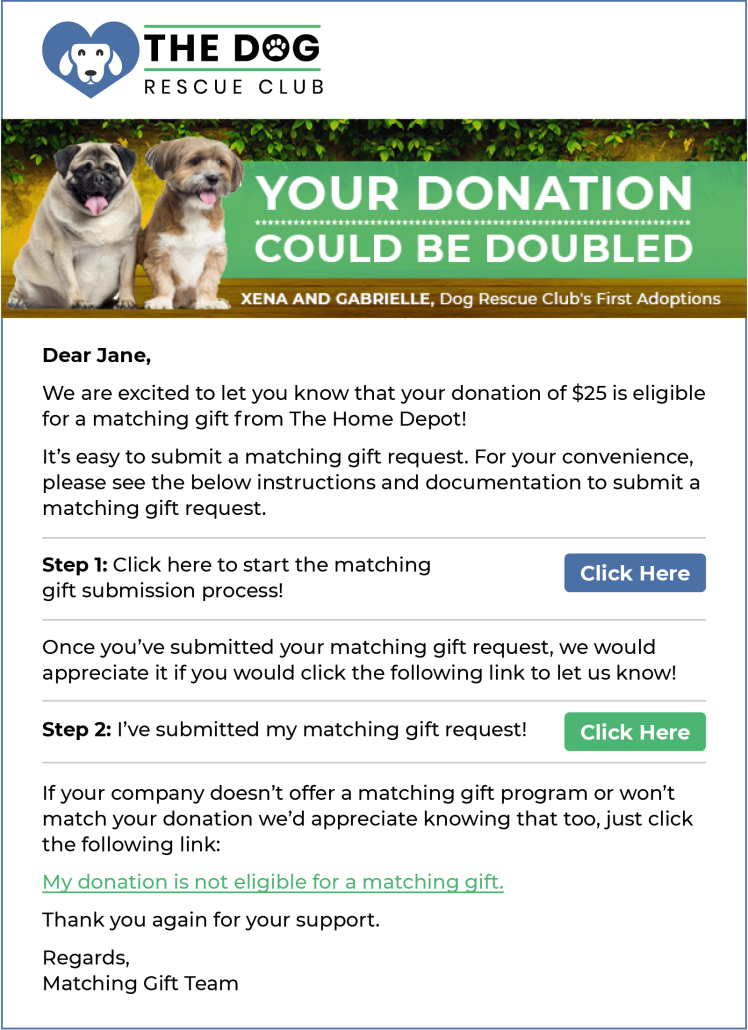
By collecting details about your donors’ employment and using matching gift automation software such as 360MatchPro, your nonprofit can automatically identify match-eligible donors and follow up with them.
Keep these best practices in mind when creating templates for your match-eligible donor letters:
- Schedule these emails to be sent within 24 hours of the donor’s gift.
- Remember to express gratitude for the donor’s contribution.
- Direct the donor to the specific steps and forms involved in their employer’s matching gift process (which tools like 360MatchPro can provide).
360MatchPro can handle everything from sending donors the exact resources they need to complete a matching gift request to following up to ensure match completion. You can customize each email with your nonprofit’s branding, send it directly from your organization, and generate specialized reports to assess campaign performance.
9. Match-Ineligible Donor Letter

Just because a donor does not seem eligible for matching gifts doesn’t mean that you shouldn’t reach out to them about these opportunities. With 360MatchPro’s platform, when an ineligible donor makes a gift to your nonprofit, they’ll trigger a follow-up email based on this eligibility status.
In your match-ineligible donor letters, you should:
- Thank the donor for their support.
- Ask the donor to verify whether or not their company has a matching gift program.
- Encourage the donor to contact their employer and advocate for a matching gift program.
While some of your donors may not currently work for employers with matching gift programs, it’s still worth making them aware of these impactful initiatives. They may eventually shift to a company that does offer matching gifts or become a spokesperson for starting one at their current place of employment.
10. Unknown Eligibility Matching Gift Letter
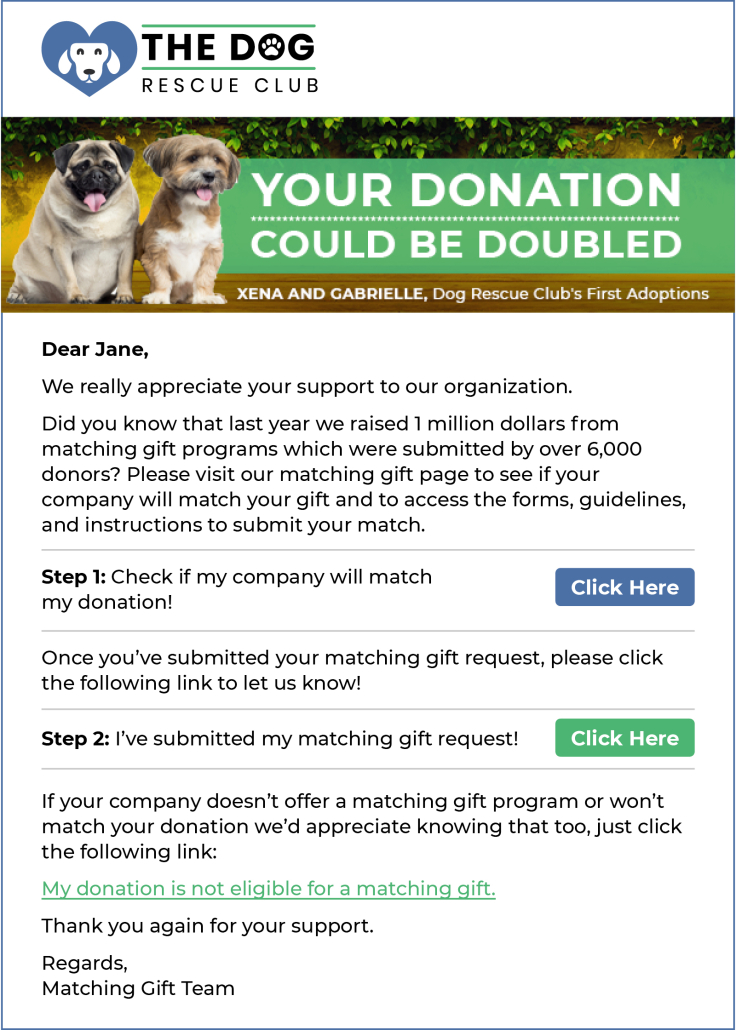
Sometimes, you may not be able to immediately identify a donor’s eligibility for matching gifts. This could be because they opted not to include any employment details during the donation process or because your nonprofit simply doesn’t have records on whether their company has a matching gift program.
In these cases, you can still send automated email follow-ups with 360MatchPro to ensure that no opportunities slip through the cracks. Similar to eligible and ineligible donors, remember to start by thanking them for their contribution. Then, invite the recipient to look up their eligibility and notify your nonprofit if their company has a matching gift program in place.
To find out more donors’ matching gift eligibility statuses, leverage up-to-date information about matching gift companies and explore specifics such as the match ratio offered and request deadlines.
11. Matching Gift Advocate Letter
If you have several donors who repeatedly make gifts to your nonprofit but don’t have matching gift programs at their company, consider sending them a matching gift advocate letter. Since they’re so passionate about your cause, they’ll likely want to find a way to amplify their support.
Use these tips to send a letter that encourages donors to advocate for a matching gift program within their company:
- Emphasize how much you appreciate the donor’s committed support.
- Link to additional resources explaining the basics of matching gift programs.
- Provide an email template the donor can send to their manager or an HR representative.
Furthermore, you can point donors toward other companies with well-established matching gift programs, such as General Electric, to help them communicate the merits of this type of corporate giving.
12. Peer-to-Peer Fundraising Matching Gift Letter
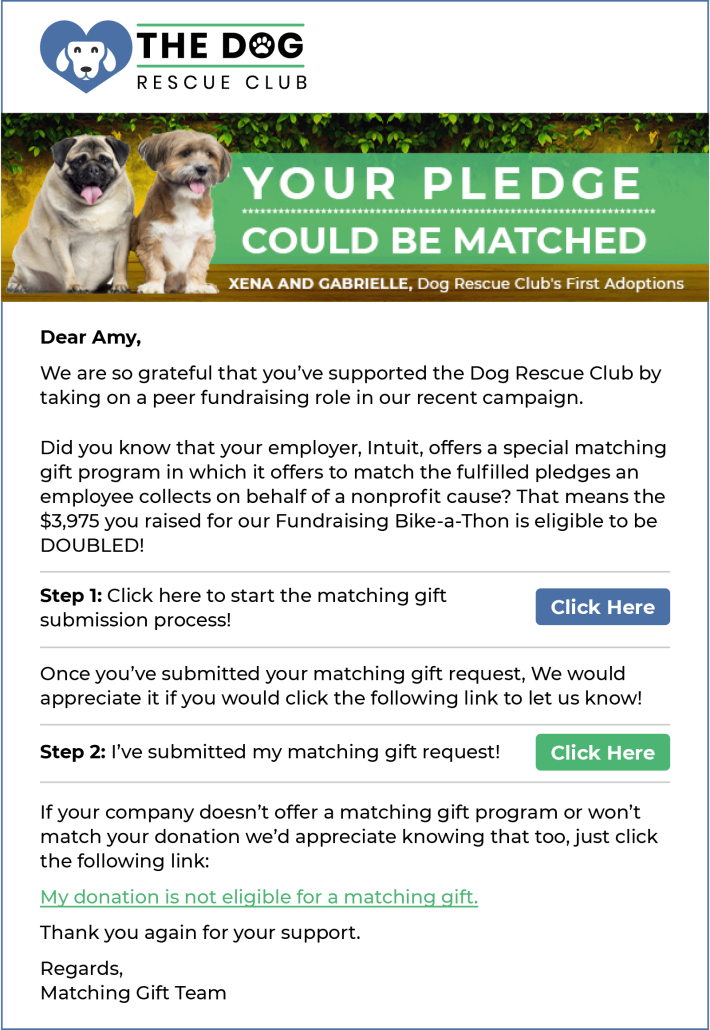
Some companies will go beyond individual employee gifts and match the funds their employees raise during peer-to-peer (P2P) fundraising events as well. For example, if one of the participants in your nonprofit’s walk-a-thon raised $1,300 from their friends and family members, they may be eligible to have that amount matched by their employer.
Send your P2P fundraisers a matching gift letter to bring these potential opportunities to their attention. Be sure to:
- Thank the fundraiser and mention the total amount they raised during your fundraiser.
- Encourage the fundraiser to check their eligibility and submit a fundraising match request.
- Ask that the fundraiser notify your nonprofit once they’ve completed their request.
Matching gift software like 360MatchPro taps into a comprehensive database of matching gift, fundraising match, and volunteer grant programs to make reaching out about these opportunities a breeze.
13. Board Member Matching Gift Letter
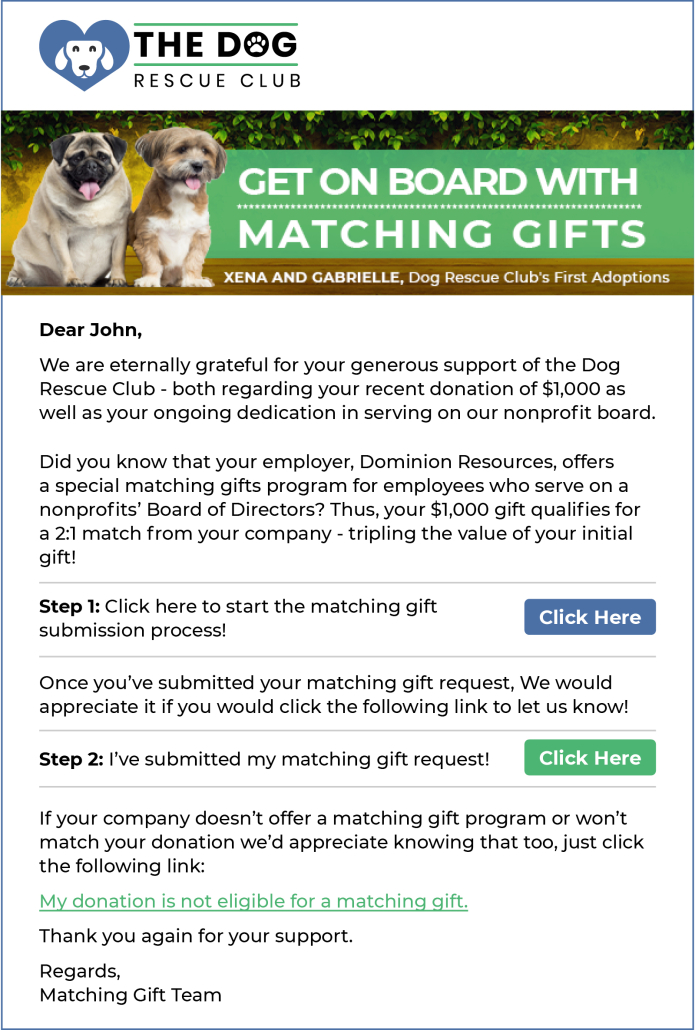
Nonprofit board giving sets an important precedent for major donors, enhances your organization’s credibility, and increases your eligibility for grant funding. As your board contributes to your mission, ensure that they don’t miss out on matching gift programs that allow them to magnify the impact of their gifts.
Follow these tips to craft matching gift letters directed specifically to your board members:
- Address the board member by name and recognize their role.
- Thank the board member for their recent gift and mention the specific amount.
- Direct the board member to their company’s matching gift forms or online portal.
Many companies even offer higher match ratios and maximum match amounts for employees who serve on a nonprofit board, which can be an even more compelling reason for your board members to get involved.
14. Challenge Gift Matching Letter
A challenge gift is a gift that an individual, corporation, or other philanthropic organization makes to your nonprofit once it meets a predetermined fundraising goal by a specific deadline. Also known as matching donation challenges, while these have some slight differences from matching gifts, sending letters to your donors is key to securing enough funds to meet the challenge requirements.
When you’re crafting your challenge gift matching letters, remember to:
- Emphasize that you need to meet the fundraising goal to secure the challenge gift.
- Mention that donors can make their gifts go even further by checking their eligibility for matching gifts.
- Link to a dedicated campaign page with a fundraising thermometer that illustrates your progress.
A successful challenge gift campaign can provide a significant boost in morale and bring your nonprofit’s community closer than ever. Don’t forget to prepare thank-you letters to send to all of your contributors after you secure the gift, too.
15. Matching Gift Submission Follow-Up Letter
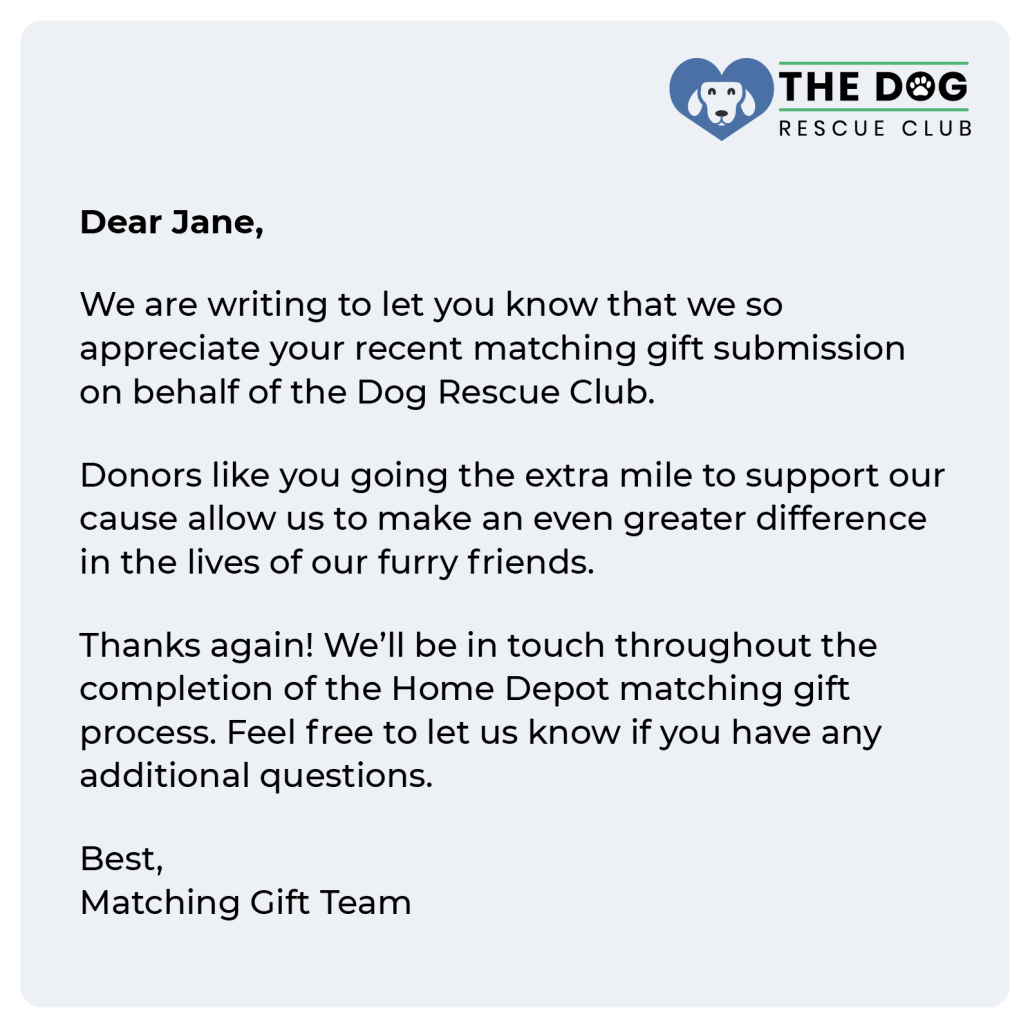
When donors notify your nonprofit that they’ve submitted a matching gift request, this is another opportunity for you to follow up and express your gratitude once more. In this type of matching gift letter, you should:
- Confirm that you’re aware of the donor’s matching gift request.
- Highlight what your nonprofit will be able to accomplish with the matched funds.
- Let the donor know that you’ll stay in touch until the request is complete.
When it comes to raising funds for your mission, every bit counts. Ensure that your donors understand this by staying connected with them throughout every step of the matching gift process.
16. Completed Match Thank-You Letter

Once you’ve obtained a completed match from a donor’s employer, follow up again so they can be sure that you’ve successfully received the funds. Keep these best practices in mind to communicate your appreciation and strengthen your donor relationships:
- Confirm that you’ve received the company match.
- Reiterate what your nonprofit plans to use the funds for.
- Encourage donors to stay in touch.
While it’s best not to make another fundraising ask in your thank-you messages, you can still invite donors to stay connected with your nonprofit. For example, you could encourage them to join your social media community so they can interact with other people who are just as passionate about your cause as they are.

How to Raise More from Matching Gift Letters with Software
Promoting matching gifts to your donors is integral to making the most of this transformational revenue source. Fortunately, with matching gift software on your side, you can automate much of your efforts and maximize awareness of these opportunities.
360MatchPro by Double the Donation is a game-changing tool for any size organization. When donors give on your website, 360MatchPro scans the details they provide and runs them against Double the Donation’s extensive matching gift database to identify if they’re eligible for a matching gift.
With this eligibility information, you can:
- Add your logo, colors, and images to brand matching gift emails to your nonprofit.
- Automatically send out variations of your matching gift letters based on determined eligibility and donor segmentation rules.
- Track email open rates, click rates, and delivery rates to measure the effectiveness of your letters.
Plus, thanks to recent innovations such as 360MatchPro’s auto-submission feature, you can make it easier than ever for donors to submit matching gift requests. As long as their company uses a CSR platform that integrates with Double the Donation’s matching gift software, all they need to do is enter their corporate email address and 360MatchPro will handle the rest of the match request.
Wrapping Up: Making Your Matching Gift Letters Count
Corporate giving presents many promising opportunities to supercharge your nonprofit’s fundraising. Adopt an improvement mindset as you continue crafting matching gift letters to spread the word to your donors. Over time, you’ll be able to secure more and more matching gifts to power your mission.
For more information on how to tap into corporate philanthropy for your nonprofit, check out these additional resources:
- How to Unlock More Social Impact With Corporate Philanthropy. Explore the benefits of corporate philanthropy, along with the most popular types of corporate philanthropy programs that nonprofits should know.
- How to Secure Corporate Sponsorships: Find Your Perfect Fit. Many companies will partner with nonprofits to help with event funding, contribute in-kind gifts, and more. Learn how to find corporate sponsorships for your nonprofit in seven steps.
- Fundraising Automation for Nonprofits: How to Boost Revenue. Discover how your nonprofit can use fundraising automation tools like 360MatchPro to secure more corporate support in this guide.

